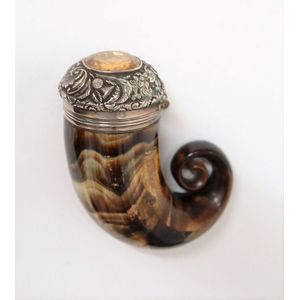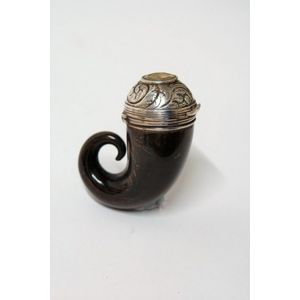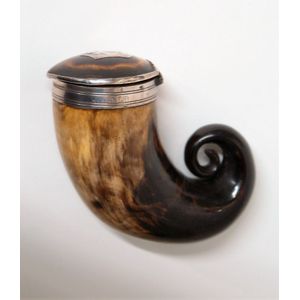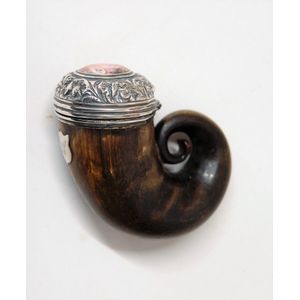Scottish Snuff Mull with Cairngorm and Horn Body
You must be a subscriber, and be logged in to view price and dealer details.
Subscribe Now to view actual auction price for this item
When you subscribe, you have the option of setting the currency in which to display prices to $Au, $US, $NZ or Stg.
- Embossed / Repousse - Embossing, also known as repousse, is the technique of decorating metal with raised designs, by pressing or beating out the design from the reverse side of the object.It is the opposite of chasing, where the decoration is applied from the front. An embossed or repoussed object may have chasing applied to finish off the design.
- Horn - Full horns were used for making drinking vessels and powder horns. A number of larger horns or antlers could be combined together to make furniture and decorative items such as chairs and lamps.
As a material, horn was formerly used in all types of objects such as snuff boxes, lanterns, musical instruments, items for personal grooming, cutlery handles, walking sticks. Some items of horn are finely decorated with silver or mounted in silver. - Cairngorm - Cairngorm is a type of smoky quartz, which is a variety of quartz that ranges in colour from light gray to dark brown. It is found in granite rock in the Cairngorm Mountains of Scotland, hence its name, and it is typically found in large clusters. The mineral is relatively hard, with a Mohs hardness of 7, and it is fairly durable, making it a suitable choice for jewellery and decorative objects.
Cairngorm is said to have spiritual and healing properties, it is believed to have grounding energy, and it is thought to help with focus and concentration. It is also said to be a stone of protection and is said to help balance the energy within the body.
The mining and collection of Cairngorms is heavily regulated in Scotland, and it is illegal to remove them from the Cairngorms National Park without a permit.
This item has been included into following indexes:
Visually similar items

A George III silver mounted ram's horn snuff mull, the fancy silver hinged lid with relief floral decoration of Britain's symbolic blooms, rose, shamrock and thistle framing the large faceted cairngorm, hallmarks to the interior lid. London 1798 by J.F.?,

An early 19th century silver and ram's horn Scottish snuff mull, the dome lid set with a pale toned cairngorm, leaf scroll cast and engraved decoration, traditional scrolling horn body. Provenance: The Flower Family Collection. Length 7 cm

A Victorian Scottish ram's horn and silver snuff mull, the hinged lid with silver fittings and engraved shield cartouche. Birmingham 1841 by James Colin. Provenance: The Flower Family Collection.

Victorian horn container with silver top
